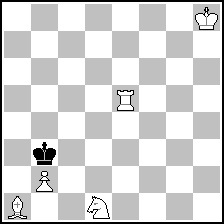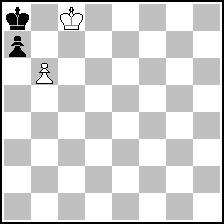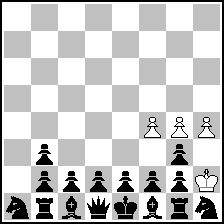
Website founded by
Milan Velimirović
in 2006
19:47 UTC


| |
MatPlus.Net  Forum Forum  General General  Problemas – October 2020, issue n. 32 Problemas – October 2020, issue n. 32 |
| |
|
|
|
|
You can only view this page!
| | | (1) Posted by Joaquim Crusats [Thursday, Oct 1, 2020 21:28] | Problemas – October 2020, issue n. 32
You are welcome to download the new issue of Problemas, the bulletin of the Spanish Society of Chess Problemists (SEPA), at the Society’s web page: http://sepa64.blogspot.com.es/p/revista-problemas-nueva-epoca.html. Along with the usual sections you will also find an article about retroanalysis in Kriegspiel problems by A. Frolkin and V. Neustadt, a continuation the article about #R Chess by C. Tylor and A. Frolkin, an article presenting i-chess (illegal chess), and three commented problems by L. Lyons. The October 2020 issue (n.32) consists of 36 pages with a total of 153 diagrams (including 55 originals), with the following contents:
150 años del nacimiento de Henri Rinck (Redacción)
Memorial Henri Rinck-150 (Redacción)
Concurso Problemas 2020 (#2, tema libre, y h#2, temático) (Redacción)
A new interpretation of Kriegspiel problems (A.Frolkin, V.Neustadt)
Introducción a las piezas de fantasía (P.Cañizares)
Nuestros concursos para el año 2021 (Redacción)
Opciones de restauración (13): bloqueo (M.Uris)
Problema selecto (I.Zurutuza)
#R Chess: many mates with later developments (A.Frolkin, C.Tylor)
El ahogado de Cook (J.M.Plantón)
Intercambio de funciones de piezas: clavada y mate (L.Gómez)
Three reflexmate twomovers with grasshoppers (L.Lyons)
Recompensas (I.Zurutuza)
Claves malas (3): fuga del rey negro (L.Gómez)
i-Chess: when illegality becomes the rule (J.Crusats, A.Frolkin)
Selección de finales (P.Cañizares)
Borrones de escribano (19) (J.A.Coello)
Ejercicio de reconstrucción nº 32 (J.A.Coello)
“It’s now or never”: a refuted en passant refutation (J.Crusats)
Concursos ajenos (Redacción)
If you want to receive (stop receiving) each new issue of Problemas by email, free of charge, send an empty email message to “sepa.problemas@gmail.com” mentioning the word “subscription” (“unsubscription”) in the subject and you will be included in (excluded from) the distribution list.
| | | (2) Posted by Sarah Hornecker [Friday, Oct 2, 2020 03:25] |
i-chess has potential.
 (= 5+1 ) (= 5+1 )
SH, original
i-chess, h#2*
Set play: 1.-Rb5+ 2.Ka2 Sc3 mate
Solution: 1.Kc4 Sf2 2.Kd4 b3 mate
 (= 2+2 ) (= 2+2 )
SH, original
i-chess (without king contact), Who wins?
It is White to move (as with Black to move, the position would be legal), but White has no move to keep the position illegal. So it is a stalemate.
| | | (3) Posted by Hauke Reddmann [Friday, Oct 2, 2020 17:06] |
I suppose this means you always may capture e.p in i-chess? :-)
| | | (4) Posted by Joaquim Crusats [Sunday, Oct 4, 2020 10:49] |
I'm glad that you liked the i-chess concept, Siegfried.
Your helpmate has a second solution: 1.Kb4 Rb5+ 2.Ka4 Sc3#
| | | (5) Posted by Sarah Hornecker [Sunday, Oct 4, 2020 15:03] |
Oops!
Unless an additional black pawn on a4 fixes that, the helpmate is defect.
| | | (6) Posted by Ulrich Voigt [Sunday, Oct 4, 2020 18:38] |
Generally, I'm not sure the rules are (or can be) well-defined. For example, one of the problems in the magazine uses castling - in an illegal position. This doesn't make sense to me: The right to castle is based on the history of the game leading to the given position. However, illegality requires there is no such history.
I had another idea:
 (= 4+16 ) (= 4+16 )
White to move. How do you assess the situation in i-Chess?
Well, obviously the position is illegal. The only possible move is Kh3, after which the position seems to be legal - but isn't, because then the only legal last move is f3-f4 with stalemate, and the "dead position" rule should have been applied before that move. But can we really apply retroanalytical arguments in illegal positions?
| | | (7) Posted by Joaquim Crusats [Sunday, Oct 4, 2020 19:46] |
Assessing whether a position is legal or not requires retroanalysis in the conventional way. I see no possible problem in the analysis of the "resulting positions" after an i-chess move has been made. A position is a position regardless of how it was originated: it is either legal or illegal. In my opinion the problem may be in the definition of "legal moves" in illegal positions (hence the use of "by-the-book" in teh article for forward i-chess moves). If we can somehow agree on the rules of these "by-the-book" moves, I see no conflict between i-chess and retroanalysis, but I may be missing the point...
| | | (8) Posted by Jakob Leck [Sunday, Oct 4, 2020 20:06] |
Siegfried, a pawn on a4 does not fix the problem: 1.a3 Rb5+ 2.Ka4 Sc3# And there is (at least) one more cook: 1.Kc4 Se3 2.Kd4 b3# Also, you do not even need the rook in the full-length solution because any move by the black king would make the position legal and is therefore not allowed.
But wait, if illegal positions are allowed in i-chess, can't black defend by playing Kc3?
Fide laws 1.2:
The objective of each player is to place the opponent’s king ‘under attack’ in such a way that the opponent has no legal move. The player who achieves this goal is said to have ‘checkmated’ the opponent’s king and to have won the game. Leaving one’s own king under attack, exposing one’s own king to attack and also ’capturing’ the opponent’s king are not allowed. The opponent whose king has been checkmated has lost the game.
I.e. leaving one's own king under attack is illegal in orthodox chess, thus i-chess-legal?
| | | (9) Posted by Joaquim Crusats [Sunday, Oct 4, 2020 20:52] |
"I.e. leaving one's own king under attack is illegal in orthodox chess, thus i-chess-legal?"
No, i-chess is about playing legal ("by-the-book") moves only (albeit in illegal positions).
| | | (10) Posted by Jakob Leck [Sunday, Oct 4, 2020 21:44] |
Sorry, my bad. It's counterintuitive... :)
Ulrich's castling remark
"The right to castle is based on the history of the game leading to the given position. However, illegality requires there is no such history."
can be resolved, I think. Illegality implies that there is no LEGAL history leading up to the diagram position. According to the codex
"Castling is permitted unless it can be proved that it is not permissible."
If the history leading up to the given position cannot have been played according to the rules, there is no way to prove that something has occurred which would have removed the right to castle (because if the rules have not been obeyed, anything could have happened). So castling should be fine as long as king and rook are on their initial squares.
| | | (11) Posted by Hauke Reddmann [Monday, Oct 5, 2020 10:04] |
@Jakob: Would be my interpretation too: castling is always legal
(if orthodox legal), e.p. always illegal in a starting position.
What move types can illegally legalize a position anyway in i-chess?
Captures.
Moving out of an impossible check.
Any composer here trying to make a 50-move-with-automatic-end? :-)
Other possibilities?
| | | (12) Posted by Joaquim Crusats [Monday, Oct 5, 2020 13:58] |
@Ulrich. Now I see what you were referring to (the mention of one of the published examples mislead me as I considered the wrong one). Certainly, retroanalysis in an illegal position is something that requires conventions. That's why we concentrated on forward play and avoided retractors, etc. However, it does indeed make sense to allow castling for the reasons exposed in this thread.
Depending on each type of illegality the orthodox moves that erase it may vary (opening cages, destroying illegal clusters, allowing past captures on certain squares, etc.)
| | | (13) Posted by Andrew Buchanan [Friday, Oct 9, 2020 08:45] |
@Joaquim (+ Andrey if he's here)
Hurray: i-Chess is a splendid idea! :D
In problem 4 of the article, why can't White play 1. ... b4? EDIT: I think this specific try is what the text (which I hadn't read) is getting at. With 1. ... a5!, BxRf2 is mate. However following the try, the mate position is legal after castling. With 1. ... a5! there is a commonly occurring retro-ratchet: wPb2-b3+ entails bKa4-a3 immediately, and wB can never retract to c1. Very ingenious. I think this unique retro try should be identified explicitly in the published solution.
Your illegal positions seem very well behaved for now. What about pawns on first/last ranks? Can pawn on e.g. 3rd rank make double move? How about promotions for pawn that began on 5th rank? FIDE Laws have an opinion. These questions have been discussed elsewhere in MatPlus, and you may want your own version. Also zero/multiple kings. Also illegal check a la Lese Majeste.
A position = diagram + the move + castling rights + e.p. status. Problems normally give diagram + usually the move. The rest is up in the air. One must, I think, construe the castling & e.p. status to force the position to be illegal if otherwise it would be legal. If there are multiple ways to force illegality, then this gives PRA-style twins. Only afterwards, for residual castling & e.p. in a position already proved to be illegal, would conventions apply (for sake of sanity, might as well have optimistic castling & pessimistic e.p.).
Handling "the move" in the same way (as in the funny Veilevater problem above) for the initial move can work, but then I think the position must remember who has just moved: can't keep checking that after every ply.
If a position can't be reached due to dead position (or 3Rep or 50M in context of conventions), then I would call this illegal these days, although there is a tedious argument that says we need another word. Would be good if the i-Chess supremos can confirm this simple perspective.
| | | (14) Posted by Joost de Heer [Friday, Oct 9, 2020 09:46] |
Can you have a posteriori i-chess? E.g. with mutually exclusive ep/castling, the key is the ep capture and the second move is castling, thereby proving the position was illegal.
| | | (15) Posted by Joaquim Crusats [Sunday, Oct 11, 2020 16:03] |
It is very inspiring that our i-chess concept is evoking so much interest. All your points are certainly interesting and may be addressed in the future.
We tried to keep the concept as simple as possible in this introductory article, showing that the concept can make sense with a minimum number of rules.
Note that the "illegality of the resulting positions", after an i-chess move has been made, is performed by "a third party" who has not seen the moves played up to that point while fulfilling the stipulation. This is precisely why the Try highlighted by Andrew is only a try. If there is an "a posteriori" remark in the stipulation, though, this could change.
| |
No more posts |
MatPlus.Net  Forum Forum  General General  Problemas – October 2020, issue n. 32 Problemas – October 2020, issue n. 32 |
|
|
|
 ISC 2024
ISC 2024 Forum
Forum  General
General  Problemas – October 2020, issue n. 32
Problemas – October 2020, issue n. 32 


